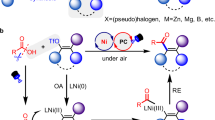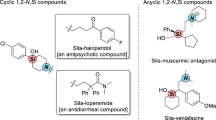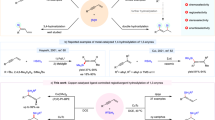Abstract
The chemical synthesis of organic molecules involves, at its very essence, the creation of carbon–carbon bonds. In this context, the aldol reaction is among the most important synthetic methods, and a wide variety of catalytic and stereoselective versions have been reported. However, aldolizations yielding tertiary aldols, which result from the reaction of an enolate with a ketone, are challenging and only a few catalytic asymmetric Mukaiyama aldol reactions with ketones as electrophiles have been described. These methods typically require relatively high catalyst loadings, deliver substandard enantioselectivity or need special reagents or additives. We now report extremely potent catalysts that readily enable the reaction of silyl ketene acetals with a diverse set of ketones to furnish the corresponding tertiary aldol products in excellent yields and enantioselectivities. Parts per million (ppm) levels of catalyst loadings can be routinely used and provide fast and quantitative product formation in high enantiopurity. In situ spectroscopic studies and acidity measurements suggest a silylium ion based, asymmetric counteranion-directed Lewis acid catalysis mechanism.
This is a preview of subscription content, access via your institution
Access options
Access Nature and 54 other Nature Portfolio journals
Get Nature+, our best-value online-access subscription
$29.99 / 30 days
cancel any time
Subscribe to this journal
Receive 12 print issues and online access
$259.00 per year
only $21.58 per issue
Buy this article
- Purchase on Springer Link
- Instant access to full article PDF
Prices may be subject to local taxes which are calculated during checkout




Similar content being viewed by others
References
List, B. et al. A Catalytic enantioselective route to hydroxy-substituted quaternary carbon centers: resolution of tertiary aldols with a catalytic antibody. J. Am. Chem. Soc. 121, 7283–7291 (1999).
Nelson, S. G. Catalyzed enantioselective aldol additions of latent enolate equivalents. Tetrahedron: Asymmetry 9, 357–389 (1998).
Mahrwald, R. Diastereoselection in Lewis-acid-mediated aldol additions. Chem. Rev. 99, 1095–1120 (1999).
Machajewski, T. D. & Wong, C.-H. The catalytic asymmetric aldol reaction. Angew. Chem. Int. Ed. 39, 1352–1375 (2000).
Mahrwald, R. Modern Aldol Reactions (Wiley-VCH, Weinheim, 2004).
Mahrwald, R. Modern Methods in Stereoselective Aldol Reactions (Wiley-VCH, Weinheim, 2013).
Cozzi, P. J., Hilgraf, R. & Zimmermann, N. Enantioselective catalytic formation of quaternary stereogenic centers. Eur. J. Org. Chem. 2007, 5969–5994 (2007).
Hatano, M. & Ishihara, K. Recent progress in the catalytic synthesis of tertiary alcohols from ketones with organometallic reagents. Synthesis 2008, 1647–1675 (2008).
Adachi, S. & Harada, T. Catalytic enantioselective aldol additions to ketones. Eur. J. Org. Chem. 2009, 3661–3671 (2009).
Elliott, M. L., Urban, F. J. & Bordner, J. Synthesis and absolute configuration of (R)- and (S)-ethyl 3-(4-oxocyclohex-2-enyl)propionate. J. Org. Chem. 50, 1752–1755 (1985).
Rodriguez, M. J. Process for performing retro-aldol reactions. US patent 5,677,423 (1996).
Matovic, R., Ivkovic, A., Manojlovic, M., Tokic-Vujosevic, Z. & Saicic, R. N. Ring closing metathesis/fragmentation route to (Z)-configured medium ring cycloalkenes. Total synthesis of (±)-periplanone C. J. Org. Chem. 71, 9411–9419 (2006).
Hatano, M., Takagi, E. & Ishihara, K. Sodium phenoxide−phosphine oxides as extremely active Lewis base catalysts for the Mukaiyama aldol reaction with ketones. Org. Lett. 9, 4527–4530 (2007).
Kobayashi, S., Fujishita, Y. & Mukaiyama, T. The efficient catalytic asymmetric aldol-type reaction. Chem. Lett. 19, 1455–1458 (1990).
Kan, S. B. J., Ng, K. K. H. & Paterson, I. The impact of the Mukaiyama aldol reaction in total synthesis. Angew. Chem. Int. Ed. 52, 9097–9108 (2013).
Matsuo, J.-I & Murakami, M. The Mukaiyama adol reaction: 40 years of continuous development. Angew. Chem. Int. Ed. 52, 9109–9118 (2013).
Denmark, S. E. & Fan, Y. Catalytic, enantioselective aldol additions to ketones. J. Am. Chem. Soc. 124, 4233–4235 (2002).
Denmark, S. E., Fan, Y. & Eastgate, M. D. Lewis base catalyzed, enantioselective aldol addition of methyl trichlorosilyl ketene acetal to ketones. J. Org. Chem. 70, 5235–5248 (2005).
Oisaki, K., Zhao, D., Kanai, M. & Shibasaki, M. Catalytic enantioselective aldol reaction to ketones. J. Am. Chem. Soc. 128, 7164–7165 (2006).
Moreau, X., Bazán-Tejeda, B. & Campagne, J.-M. Catalytic and asymmetric vinylogous Mukaiyama reactions on aliphatic ketones: formal asymmetric synthesis of taurospongin A. J. Am. Chem. Soc. 127, 7288–7289 (2005).
Kaib, P. S. J., Schreyer, L., Lee, S., Properzi, R. & List, B. Extremely active organocatalysts enable a highly enantioselective addition of allyltrimethylsilane to aldehydes. Angew. Chem. Int. Ed. 55, 13200–13203 (2016).
Xie, Y. et al. Catalytic asymmetric vinylogous Prins cyclization: a highly diastereo- and enantioselective entry to tetrahydrofurans. J. Am. Chem. Soc. 138, 14538–14541 (2016).
Lee, S., Kaib, P. S. J. & List, B. Asymmetric catalysis via cyclic, aliphatic oxocarbenium ions. J. Am. Chem. Soc. 139, 2156–2159 (2017).
Liu, L. et al. Catalytic asymmetric [4+2]-cycloaddition of dienes with aldehydes. J. Am. Chem. Soc. 139, 13656–13659 (2017).
Gatzenmeier, T., Kaib, P. S. J., Lingnau, J. B., Goddard, R. & List, B. The catalytic asymmetric Mukaiyama–Michael reaction of silyl ketene acetals with α,β-unsaturated methyl esters. Angew. Chem. Int. Ed. 57, 2464–2468 (2018).
Mahlau, M. & List, B. Asymmetric counteranion-directed catalysis: concept, definition, and applications. Angew. Chem. Int. Ed. 52, 518–533 (2013).
García-García, P., Lay, F., García-García, P., Rabalakos, C. & List, B. A powerful chiral counteranion motif for asymmetric catalysis. Angew. Chem. Int. Ed. 48, 4363–4366 (2009).
Ratjen, L., Garcia-Garcia, P., Lay, F., Beck, M. E. & List, B. Disulfonimide-catalyzed asymmetric vinylogous and bisvinylogous Mukaiyama aldol reactions. Angew. Chem. Int. Ed. 50, 754–758 (2011).
Tap, A., Blond, A., Wakchaure, V. N. & List, B. Chiral allenes via alkynylogous Mukaiyama aldol reaction. Angew. Chem. Int. Ed. 55, 8962–8965 (2016).
van Gemmeren, M., Lay, F. & List, B. Asymmetric catalysis using chiral, enantiopure disulfonimides. Aldrichimica Acta 47, 3–13 (2014).
James, T., van Gemmeren, M. & List, B. Development and applications of disulfonimides in enantioselective organocatalysis. Chem. Rev. 115, 9388–9409 (2015).
Giacalone, F., Gruttadauria, M., Agrigento, P. & Noto, R. Low-loading asymmetric organocatalysis. Chem. Soc. Rev. 41, 2406–2447 (2012).
Park, S. Y., Lee, J.-W. & Song, C. E. Parts-per-million level loading organocatalysed enantioselective silylation of alcohols. Nat. Commun. 6, 7512 (2015).
Xu, W. et al. Metal-templated design: enantioselective hydrogen-bond-driven catalysis requiring only parts-per-million catalyst loading. J. Am. Chem. Soc. 138, 8774–8780 (2016).
Zhang, Z. & List, B. Kinetics of the chiral disulfonimide-catalyzed Mukaiyama aldol reaction. Asian J. Org. Chem. 2, 957–960 (2013).
Zhang, Z. et al. Asymmetric counteranion-directed Lewis acid organocatalysis for the scalable cyanosilylation of aldehydes. Nat. Commun. 7, 12478 (2016).
Song, J. J. et al. N-Heterocyclic carbene-catalyzed silyl enol ether formation. Org. Lett. 10, 877–880 (2008).
Acknowledgements
Support from the Max Planck Society, the Deutsche Forschungsgemeinschaft (Leibniz Award to B.L. and Cluster of Excellence RESOLV, EXC 1069) and the European Research Council (Advanced Grant ‘C–H Acids for Organic Synthesis, CHAOS’) is acknowledged. The authors thank J.L. Kennemur for her suggestions during the preparation of this manuscript, P. Gupta for his assistance on the preparation of artwork, the technicians of our group, and the members of our NMR, MS and HPLC departments for their excellent service. The work of K.K. and I.L. was supported by grant IUT20-14 from the Estonian Ministry of Education and Research. This paper is dedicated to Prof. T. Mukaiyama in celebration of his 90th birthday (Sotsuju).
Author information
Authors and Affiliations
Contributions
H.Y.B. developed the reaction and investigated the substrate scope, derivatizations of the aldol products, and implemented in situ FT-IR study. D.H. first observed the high activity of IDPi catalysts in the described reaction. The IDPi catalysts were developed by H.Y.B., P.S.J.K. and B.L. H.Y.B., P.S.J.K., P.K. and S.L. synthesized the IDPi catalysts used in this study. H.Y.B., C.K.D. and A.D. investigated large-scale and low-catalyst loading experiments. K.K. and I.L. measured pKa values of acid catalysts. B.L. designed and oversaw the project. H.Y.B. and B.L. wrote the manuscript.
Corresponding author
Ethics declarations
Competing interests
The authors declare no competing interests.
Additional information
Publisher’s note: Springer Nature remains neutral with regard to jurisdictional claims in published maps and institutional affiliations.
Supplementary information
Supplementary Information
Supplementary experimental data, synthetic procedures and chemical compound characterization data
Rights and permissions
About this article
Cite this article
Bae, H.Y., Höfler, D., Kaib, P.S.J. et al. Approaching sub-ppm-level asymmetric organocatalysis of a highly challenging and scalable carbon–carbon bond forming reaction. Nature Chem 10, 888–894 (2018). https://doi.org/10.1038/s41557-018-0065-0
Received:
Accepted:
Published:
Issue Date:
DOI: https://doi.org/10.1038/s41557-018-0065-0
This article is cited by
-
Catalytic asymmetric cationic shifts of aliphatic hydrocarbons
Nature (2024)
-
Harnessing the ambiphilicity of silyl nitronates in a catalytic asymmetric approach to aliphatic β3-amino acids
Nature Catalysis (2021)
-
Chiral paddle-wheel diruthenium complexes for asymmetric catalysis
Nature Catalysis (2020)
-
Safe, sustainable and scalable
Nature Chemistry (2019)



